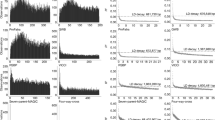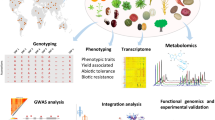Abstract
Key message
Extent and overlap of segregation distortion regions in 12 barley crosses determined via a Pool-GBS approach.
Abstract
Segregation distortion is undesirable as it alters the frequency of alleles and can reduce the chances of obtaining a particular combination of alleles. In this work, we have used a pooled genotyping-by-sequencing (Pool-GBS) approach to estimate allelic frequencies and used it to examine segregation distortion in 12 segregating populations of barley derived from androgenesis. Thanks to the extensive genome-wide SNP coverage achieved (between 674 and 1744 markers), we determined that the proportion of distorted markers averaged 28.9 % while 25.3 % of the genetic map fell within segregation distortion regions (SDRs). These SDRs were characterized and identified based on the position of the marker showing the largest distortion and the span of each SDR. Summed across all 12 crosses, 36 different SDR peaks could be distinguished from a total of 50 SDRs and a majority of these SDRs (27 of 36) were observed in only one population. While most shared SDRs were common to only two crosses, two SDRs (SDR3.1 and SDR4.2) were exceptionally recurrent (seen in five and four crosses, respectively). Because of the broad span of most SDRs, an average of 30 % of crosses showed segregation distortion in any given chromosomal segment. In reciprocal crosses, although some SDRs were clearly shared, others were unique to a single direction. In summary, segregation distortion is highly variable in its extent and the number of loci underpinning these distortions seems to be quite large even in a narrow germplasm such as six-row spring barley.






Similar content being viewed by others
References
Bélanger S, Esteves P, Clermont I, Jean M, Belzile F (2016) Genotyping-by-sequencing on pooled samples (Pool-GBS) and its use in measuring segregation bias during the course of androgenesis in barley. Plant Genome. doi:10.3835/plantgenome2014.10.0073
Cantalapiedra CP, Boudiar R, Casas AM, Igartua E, Contreras-Moreira B (2015) BARLEYMAP: physical and genetic mapping of nucleotide sequences and annotation of surrounding loci in barley. Mol Breed 35:13. doi:10.1007/s11032-015-0253-1
Cleveland WS, Grosse E, Shyu WM (1992) Local regression models. In: Chambers JM, TJ Hastie (eds) Statistical models in S, Chap 8. Wadsworth & Brooks/Cole, Pacific Grove
Cui XP, Xu J, Asghar R, Condamine P, Svensson JT, Wanamaker S, Stein N, Roose M, Close TJ (2005) Detecting single-feature polymorphisms using oligonucleotide arrays and robustified projection pursuit. Bioinfomatics 21:3852–3858. doi:10.1093/bioinformatics/bti640
Devaux P, Zivy M (1994) Protein markers for anther culturability in barley. Theor Appl Genet 88:701–706. doi:10.1007/BF01253973
Devaux P, Kilian A, Kleinhofs A (1995) Comparative mapping of the barley genome with male and female recombination-derived, doubled haploid populations. Mol Gen Genet 249(6):600–608. doi:10.1007/BF00418029
Elshire RJ, Glaubitz JC, Sun Q, Poland JA, Kawamoto K, Buckler ES, Mitchell SR (2011) a robust, simple genotyping-by-sequencing (GBS) approach for high diversity species. PLoS One 6(5):e19379. doi:10.1371/journal.pone.0019379
Esteves P, Belzile F (2014) Improving the efficiency of isolated microspore culture in six-row spring barley: I-optimization of key physical factors. Plant Cell Rep 33(6):993–1001. doi:10.1007/s00299-014-1583-x
Esteves P, Clermont I, Marchand S, Belzile F (2014) Improving the efficiency of isolated microspore culture in six-row spring barley: II-exploring novel growth regulators to maximize embryogenesis and reduce albinism. Plant Cell Rep 33(6):871–879. doi:10.1007/s00299-014-1563-1
Germanà MA (2011) Gametic embryogenesis and haploid technology as valuable support to plant breeding. Plant Cell Rep 30:839–857. doi:10.1007/s00299-011-1061-7
Graner A, Jahoor A, Schondelmaier J, Siedler H, Pillen K, Fischbeck G, Wenzel G, Herrmann RG (1991) Construction of an RFLP map of barley. Theor Appl Genet 83:250–256. doi:10.1007/BF00226259
Li H, Kilian A, Zhou M, Wenzl P, Huttner E, Mendham N, McIntyre L, Vaillancourt RE (2010) Construction of a high-density composite map and comparative mapping of segregation distortion regions in barley. Mol Genet Genom 284:319–331. doi:10.1007/s00438-010-0570-3
Lu F, Lipka AE, Glaubitz J, Elshire R, Cherney JH, Casler MD, Buckler ES, Costich DE (2013) Switchgrass genomic diversity, ploidy, and evolution: novel insights from a network-based SNP discovery protocol. PLoS Genet 9(1):e1003215. doi:10.1371/journal.pgen.1003215
Manninen OM (2000) Associations between anther-culture response and molecular markers on chromosomes 2H, 3H and 4H of barley (Hordeum vulgare L.). Theor Appl Genet 100:57–62. doi:10.1007/s001220050008
Poland JA, Brown PJ, Sorrells ME, Jannink JL (2012) Development of high-density genetic maps for barley and wheat using a novel two-enzyme genotyping-by-sequencing approach. PLoS One 7(2):e32253. doi:10.1371/journal.pone.0032253
Powell W, Borrino EM, Allison MJ, Griffiths DW, Asher MJC, Dunwell JM (1986) Genetical analysis of microspore derived plants of barley (Hordeum vulgare). Theor Appl Genet 72:619–626. doi:10.1007/BF00288999
Sayed H, Kayyal H, Ramsey L, Ceccarelli S, Baum M (2002) Segregation distortion in doubled haploid lines of barley (Hordeum vulgare L.) detected by simple sequence repeat (SSR) markers. Euphytica 225:265–272. doi:10.1023/A:1015861610226
Wickham H (2009) ggplot2: elegant graphics for data analysis. Springer, New York ISBN: 978-0-387-98140-6
Zhang LY, Marchand S, Tinker NA, Belzile F (2009) Population structure and linkage disequilibrium in barley assessed by DArT markers. Theor Appl Genet 119(1):43–52. doi:10.1007/s00122-009-1015-4
Acknowledgments
S. Bélanger gratefully acknowledges graduate studentships from the Fonds de recherche nature et technologies of Quebec (FRQNT). This work was also supported by a research grant from the Natural Sciences and Engineering Research Council (NSERC) of Canada to F. Belzile.
Author information
Authors and Affiliations
Corresponding author
Ethics declarations
Conflict of interest
The authors declare that they have no conflict of interest.
Additional information
Communicated by D. E. Mather.
Electronic supplementary material
Below is the link to the electronic supplementary material.
122_2016_2711_MOESM1_ESM.docx
Supplementary Fig. 1 Distribution of SNP markers and their allelic frequency across all chromosomes and populations. The genetic map position of the markers on the barley consensus map (x-axis, in cM) and the estimated allelic frequency at each locus (y-axis) are plotted. Each dot shows the actual allelic frequency estimated based on the read counts supporting each allele. The solid curved lines show the regression that best fits the variation in allelic frequency. Red and green are used to identify the parental origin of the alleles while the dotted red lines indicate the values above or below which segregation distortion was significant (q value < 0.01)
122_2016_2711_MOESM2_ESM.docx
Supplementary Fig. 2 Distribution and overlap of segregation distortion regions (SDRs) observed across DH barley populations of this study and previous studies. The line to the left of the schematized chromosome (grey bar) indicates the genetic position (in cM). Colored bars illustrate the location and span of segregation distortion regions while a black oval indicates the position of the marker showing the largest distortion (SDR peak) observed in 12 barley population of this work. Markers exhibiting a significant segregation distortion in three previously studied populations (Igri x Franka in Graner et al. 1991; TX9425 x Franklin and Yerong x Franklin in Li et al. 2010) were positioned (when possible) on the same genetic map and show the location of previously reported SDRs (dotted lines)
Rights and permissions
About this article
Cite this article
Bélanger, S., Clermont, I., Esteves, P. et al. Extent and overlap of segregation distortion regions in 12 barley crosses determined via a Pool-GBS approach. Theor Appl Genet 129, 1393–1404 (2016). https://doi.org/10.1007/s00122-016-2711-5
Received:
Accepted:
Published:
Issue Date:
DOI: https://doi.org/10.1007/s00122-016-2711-5




